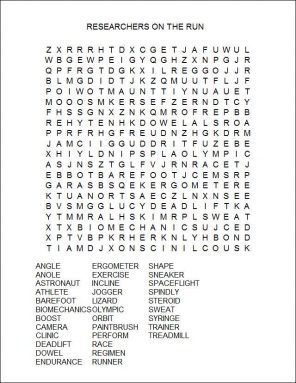Cool Jobs: Researchers on the run
Scientists are studying runners of all kinds, from reptiles to astronauts, to help everyone exercise better
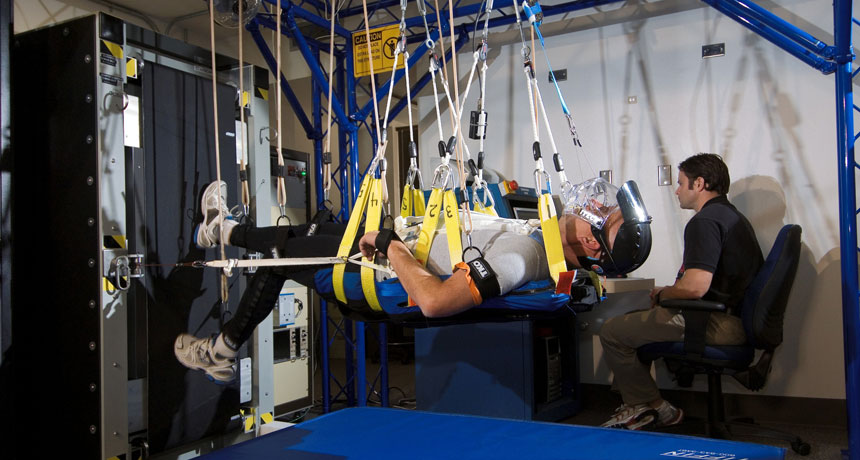
A vertical treadmill helps NASA researchers on Earth simulate zero-gravity running in space.
NASA
Jerry Husak never expected to be an athletic trainer, let alone a lizard trainer. Yet he’s become an expert at getting the little reptiles to race on a treadmill. His secret? Once in a while, gently prod their tails or back legs with a paintbrush.
Husak is a biologist at the University of St. Thomas in St. Paul, Minn. Although he calls his subjects “Olympic lizards,” he’s not readying them for competition. Instead, their training is helping his team learn about the effects of exercise in all animals — including people.
From professional sports stars to casual joggers, human athletes are always trying to perform better. Even non-athletes want to know how they can stay in shape without getting injured. That’s why exercise scientists bring athletes — and animals — into the lab. They want to learn what happens inside a moving body and what can go wrong.
Here are three researchers who are studying the science of running — the simplest kind of exercise — to help improve the health of all athletes. This research may use ordinary treadmills, but these lab tests are far from routine. And sometimes their athletes aren’t even on this planet.
Olympic lizards
While a college student interested in biology, Husak figured he’d do something normal — maybe become a doctor. But then he started working with a professor who studied lizards. “I found that [the animals] were just fascinating,” he recalls.
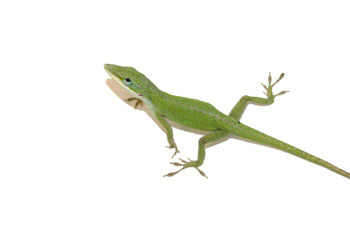
Husak now studies lizards, too. Called green anoles, they’re slender, with spindly toes and long tails. From snout to tail-tip, they’re only about as long as an adult’s hand. Husak admits that these animals don’t make very exciting pets. “They do a lot of sitting around,” he explains. But when he travels to places like the Bahamas to study anoles in the wild, he enjoys watching them interact with each other in the trees, search for food and run from predators. Plus, he says, the lizards have personalities. You can see that in the lab, he says, by the way they behave toward each other and people.
Aside from their other charming features, these anoles make great lab animals. Because they’re small, he can keep many in the lab at once. And in some ways, they’re a good model for people. After all, he notes, body systems — from muscles to hormones — are “pretty much the same” whether an animal is a lizard or human.
Husak’s experiments with lizards began with research into steroid drugs. Human athletes may take these illegally to boost their performance. It can be easier and safer to study the drugs in controlled tests with lab animals. Their bodies can be good models for people. But to model the effect of steroids on human athletes, Husak had to turn his animals into athletes.
He wasn’t sure if this would even be possible with lizards, the lab animals he prefers. But he decided to try. Through trial and error — and a little luck — he found an exercise regimen that worked.
In the lab, his team worked with two groups of lizard athletes. Those in one group became endurance runners. Three times a week, they’d spend half an hour on a treadmill.
“We prod them along at what seems to us like a really slow speed,” Husak says. “But to them it’s challenging.” The lizards move at about two-tenths of a kilometer (a tenth of a mile) per hour. Every two or three weeks, as the lizards get in better shape, the researchers make the workout a bit tougher by making the treadmill’s incline a little steeper.
Lizards in the second group are sprinters. To train them, the researchers place the animals at one end of a slanted wooden dowel that’s wrapped in cork. They train the lizards by chasing them up the dowel several times, a few days each week. As with the endurance lizards, the researchers gradually make the workout harder by changing the angle of the stick.
Whenever the exercise gets more intense, the lizards struggle at first. But then they improve, just as a human athlete does.
Now that he knows it’s possible to train anoles, Husak wants to learn about the tradeoffs that come with exercise. Any animal’s body, including a human’s, has only a certain amount of energy to spend. It can put that energy toward things like growing, reproducing and fighting disease. Whenever it spends extra energy in one area, it has to adjust its budget and cut how much energy it spends somewhere else.
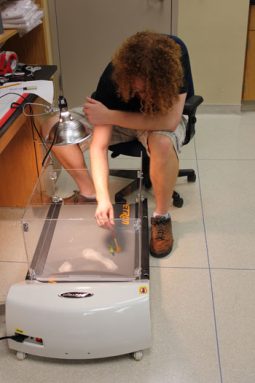
When athletes spend a lot of energy on training, what other activities lose out? Although he started out asking about steroids, this is the question Husak now hopes to answer with his lizards. He’s already learned that when the lizards are exercising intensely, they dial down their reproductive and immune systems. The same effects can be seen in human athletes who do intense training. Understanding these tradeoffs in reptiles could help scientists learn how to keep human athletes in better shape.
Husak already uses what he’s found to exercise smarter himself. “It’s made me realize that I need to better balance what I’m doing,” he says. Rather than only focusing on running or lifting weights, which might be hard on his body, he tries to do a mix of activities. He also knows from his lizards that spending too much energy exercising can take away from the immune system. “If you push yourself too hard, you’re much more likely to get sick.”
When college students join his lab, Husak says, they’re often like he was long ago. They’re not sure what they want to do for a career. They’re also a bit uncertain about reaching into a cage and grabbing some squirming lizard. But soon they’re gathering data like old pros.
“It’s good to explore your interests,” Husak finds. Even if you don’t end up with a career in science, you might learn how to coach a lizard.
Technology in motion
Irene Davis directs the Spaulding National Running Center, which is linked to Harvard Medical School, in Cambridge, Mass. Because she works with people, she doesn’t have to chase or poke her subjects to keep them running on a treadmill.
Early in her career, Davis worked as a physical therapist. Later, she went back to school and got a PhD in biomechanics, the study of how living things move. Before coming to Spaulding Center, she spent two decades doing research on running and walking, as well as the injuries people get from those activities. Then she came to Cambridge — “a community that’s rich with runners,” she says — to start the running center.
At Spaulding, injured runners can meet with therapists in a clinic. There’s also a research lab that studies the science of running. Patients in the clinic help researchers figure out what questions to study in the lab. The answers they turn up help the running center treat new patients more effectively.
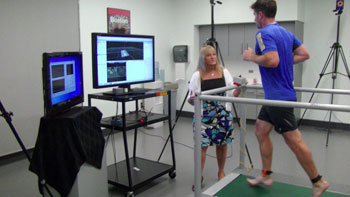
One technology in the lab is the same one that moviemakers use to turn actors into computer-generated characters. Researchers stick reflective dots to a person’s body. Then they ask the person to run on a treadmill while high-speed cameras capture the action. Instead of creating an alien for the next
Star Wars
movie, the researchers use the images to study the angles of the person’s joints. This lets them analyze how the person is moving.
“We have a very cool, high-tech laboratory,” Davis says. In addition to the cameras, there are plates embedded in the floor. They measure how strongly a person pushes off with each step.
Other new tools let researchers study biomechanics outdoors. Instead of exercising inside a lab, a volunteer runs normally. A device attached to the ankle can measure how hard the runner’s foot strikes the ground with each step. Or an instrument on the leg might record the angles of the person’s joints while running. These tools let runners — and researchers — get feedback in real time.
Davis says one of the most significant things her team has learned is about the cushioning in running shoes. You might think a soft, springy shoe makes your feet land more gently, protecting you from injuries. But Davis says her research shows the opposite is true. In an extra-cushy sneaker, feet hit the ground just as hard as in a normal shoe, or harder. This might affect how likely a runner is to get injured.
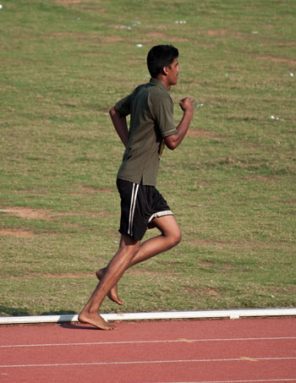
Davis herself is a runner, but she doesn’t wear cushioned shoes. In fact, she doesn’t wear shoes at all — she runs completely barefoot. She thinks running in this most natural state is best.
But other research has suggested that barefoot running isn’t a good idea for everyone. It’s a fairly new area of science. And our understanding of how to exercise best is changing all the time, Davis says.
That’s something scientists in every field have to remember, she adds. “You have to keep your mind open to new and changing knowledge.”
How to run in space
Some athletes are able to exercise where there’s no ground at all. And they can thank Linda Loerch. At NASA’s Johnson Space Center in Houston, Tex., she oversees the labs where scientists test exercise equipment — and plan workout routines — for astronauts.
Exercise is crucial for these space travellers because life without gravity has side effects. When people spend time in space, their muscles and bones shrink. As a result, they become less fit. And if astronauts spent a lot of time floating around without running or walking, their bodies would have a hard time remembering how to do those things once they got back to Earth. Exercise helps fight those effects of living in the absence of gravity.
So how do you exercise in space? After all, you can’t run laps around the space station. An astronaut has to be harnessed down, Loerch explains. If not, he notes, “They’ll float away!” And lifting weights isn’t simple when the weights, like the astronauts, don’t weigh anything.
Loerch started working at Johnson Space Center while NASA was still sending astronauts on Space Shuttle missions. (These spacecraft were retired in 2011.) She had been working with heart patients in New Hampshire when she learned about an opportunity to do exercise research for astronauts. “That sounded fantastic,” she recalls.
On Space Shuttle missions, astronauts could use a cycle and a treadmill, but they didn’t always return in tiptop shape. At first, Loerch and her colleagues focused on learning what astronauts lost while they were in space. How much weaker were their muscles when they got back to Earth? How physically fit were they?
Today, NASA’s astronauts work together with astronauts from other countries on the International Space Station. And based on what Loerch and her colleagues have learned, NASA astronauts exercise a lot compared with those of us on the ground. Two and a half hours every day is dedicated to exercise, Loerch says. That isn’t all running and sweating; it includes time spent setting up the equipment.
The astronauts use three pieces of equipment on the space station. It’s “kind of a mini gym,” Loerch says. The cycle ergometer is like an exercise bike with no seat or handlebars. Astronauts simply clip their feet to the pedals and float above it.
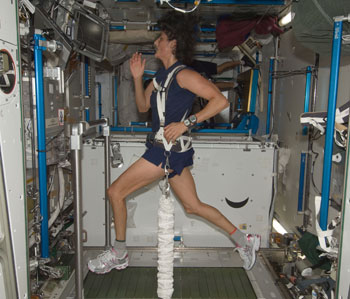
There’s also a treadmill. It’s similar to one you might use on Earth — except for all the straps. Astronauts use a harness to keep from floating off of it. When they’re hooked in, the harness pushes down on their shoulders and hips to simulate running in Earth’s gravity. It’s not very comfortable. Still, NASA astronaut Sunita Williams ran a whole marathon this way in 2007. British astronaut Tim Peake plans to do the same thing this coming April.
The third piece of equipment is the Advanced Resistive Exercise Device, or ARED (pronounced “A-red”). It works like a weight machine on Earth but looks quite different. “Engineers had to get quite creative” to build a weight machine that works during spaceflight, Loerch says. To create resistance, ARED uses technologies such as vacuum tubes — think of pulling up the plunger in a syringe. Astronauts use the machine for exercises like squats, deadlifts and heel raises.
All the exercise devices have more equipment underneath them that absorbs the pounding from the astronauts. Otherwise, all that thudding and vibration would travel into the walls of the space station. This could damage delicate experiments happening onboard and even interfere with the station’s orbit.
Because there are only a few astronauts on the space station at a time, it can take years for Loerch’s researchers to gather much data. But they’ve made some important discoveries about astronaut exercise. For example, the researchers have learned that interval training is helpful — running in short, intense bursts, for instance, rather than just jogging at one speed. It’s also important for astronauts to start exercising as soon after getting onboard as they can to avoid losing fitness.
By the 2030s, NASA hopes to send astronauts to Mars. That will mean new challenges for exercise scientists. They’ll need to make equipment that’s small and lightweight so that it can travel to Mars with the crew. And they’ll need to find ways to keep the astronauts from getting bored. During a trip that could take two or three years, “How do we make exercise interesting?” Loerch says.
If the astronauts can keep working out and stay healthy, they’ll be able to explore unseen parts of the solar system. That’s many small steps for a human on a treadmill, and one giant leap for humankind.
This is one in a series on careers in science, technology, engineering and mathematics made possible with generous support from Alcoa Foundation.
Power Words
(for more about Power Words, click here)
astronaut Person trained to travel into space for research and exploration.
biology The study of living things. The scientists who study them are known as biologists.
biomechanics The study of how living things move, especially of the forces exerted by muscles and gravity on the skeletal structure.
ergometer A device that measures energy use as people undertake a long period of physical exercise. It gets its name from erg — a unit of energy or work, and meter — a device for measuring something.
feedback A process or combination of process that propel or exaggerate a change in some direction. For instance, as the cover of Arctic ice disappears with global warming, less of the sun’s warming energy will be reflected back into space. This will serve to increase the rate of Earth’s warming. That warming might trigger some feedback (like sea-ice melting) that fosters additional warming
gravity The force that attracts anything with mass, or bulk, toward any other thing with mass. The more mass that something has, the greater its gravity.
green anole A small lizard, native to the southeastern United States and parts of the Caribbean, that’s often used in laboratory research.
hormone (in zoology and medicine) A chemical produced in a gland and then carried in the bloodstream to another part of the body. Hormones control many important body activities, such as growth. Hormones act by triggering or regulating chemical reactions in the body.
immune system The collection of cells and their responses that help the body fight off infections and deal with foreign substances that may provoke allergies.
International Space Station An artificial satellite that orbits Earth. Run by the United States and Russia, this station provides a research laboratory from which scientists can conduct experiments in biology, physics and astronomy — and make observations of Earth.
lizard A type of reptile that typically walks on four legs, has a scaly body and a long tapering tail. Unlike most reptiles, lizards also typically have movable eyelids. Examples of lizards include the tuatara, chameleons, Komodo dragon, and Gila monster.
National Aeronautics and Space Administration Created in 1958, this U.S. agency has become a leader in space research and in stimulating public interest in space exploration. It was through NASA that the United States sent people into orbit and ultimately to the moon. It has also sent research craft to study planets and other celestial objects in our solar system.
orbit The curved path of a celestial object or spacecraft around a star, planet or moon. One complete circuit around a celestial body.
PhD (also known as a doctorate) A type of advanced degree offered by universities — typically after five or six years of study — for work that creates new knowledge. People qualify to begin this type of graduate study only after having first completed a college degree (a program that typically takes four years of study).
physical therapist A person trained in the treatment of physical disability through the use of exercise, massage or other non-medical treatments.
reptile Cold-blooded vertebrate animals, whose skin is covered with scales or horny plates. Snakes, turtles, lizards and alligators are all reptiles.
resistance (as in exercise) A type of rather sedentary exercise that relies on the contraction of muscles to build strength in localized tissues.
space shuttles The world’s first reusable vehicles, NASA’s five space shuttles (Columbia, Challenger, Discovery, Endeavor and Atlantic) ferried astronauts and cargo into orbit, including to service satellites (like the Hubble Space Telescope) and the International Space Station. The first shuttle launched on April 12, 1981. On July 21, 2011, a shuttle returned home for the last time. After that trip, the program was retired. In all NASA’s shuttles tackled 135 missions.
steroids A class of chemical compounds. They include hormone mimics that are taken illegally by athletes to improve performance.
technology The application of scientific knowledge for practical purposes, especially in industry — or the devices, processes and systems that result from those efforts.
vacuum Space with little or no matter in it. Laboratories or manufacturing plants may use vacuum equipment to pump out air.
Word Find (click here to enlarge for printing)
